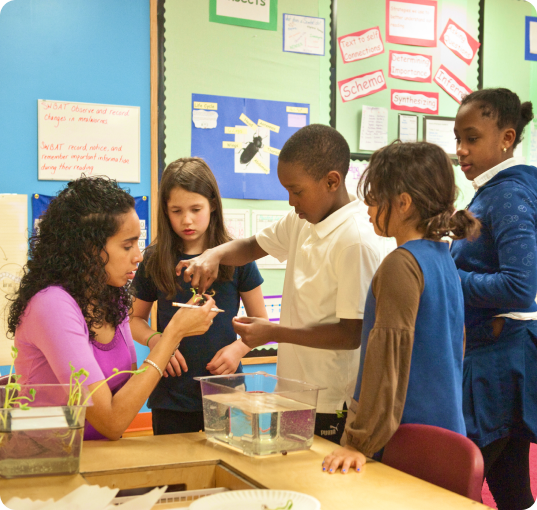Primary Science Tuition Singapore for Building Confidence in Science
Primary Science Tuition Singapore for Building Confidence in Science
Blog Article
Checking Out the Various Teaching Techniques in Primary Scientific Research Education And Learning Today
The landscape of key science education and learning is progressing, with numerous mentor strategies gaining prominence in modern classrooms. Inquiry-based knowing, hands-on experiments, and the integration of technology are redefining just how teachers involve young minds. In addition, collective methods and distinguished guideline are being utilized to accommodate the varied needs of pupils, improving both engagement and understanding. As we examine these approaches, questions occur regarding their effectiveness and the implications for future academic practices. What might these shifts in technique mean for the future generation of students?
Inquiry-Based Discovering
Inquiry-Based Discovering (IBL) is a pedagogical strategy that motivates trainees to explore scientific concepts via wondering about, investigation, and hands-on testing. This approach emphasizes the function of pupils as active individuals in their understanding, promoting crucial thinking and problem-solving skills. By involving with real-world questions, pupils end up being determined and interested, which enhances their understanding of scientific concepts.
In IBL, teachers serve as facilitators, assisting trainees as they navigate their inquiries instead of providing details directly. This student-centered strategy permits differentiation, accommodating numerous discovering designs and rates. Students develop skills in developing theories, designing experiments, and evaluating information, which are essential for clinical literacy.
Additionally, IBL cultivates cooperation among students, motivating them to share concepts and searchings for. This collective query advertises social abilities and a sense of neighborhood within the classroom. In addition, the procedure of inquiry encourages strength, as trainees find out to embrace failure as a tipping rock toward understanding.
Hands-On Experiments
Hands-on experiments are a crucial component of reliable scientific research education and learning, matching the concepts of inquiry-based learning. These experiments permit pupils to involve directly with scientific ideas, cultivating a much deeper understanding via experiential discovering. By adjusting materials and observing outcomes, young learners can comprehend abstract theories in substantial ways.
Such activities promote crucial reasoning and analytical skills, as pupils hypothesize end results, conduct experiments, and examine outcomes. This process encourages them to ask concerns, fine-tune their understanding, and create a clinical way of thinking. In addition, hands-on experiments can be customized to varied knowing styles, ensuring that all students have the chance to involve meaningfully with the material.
In addition, hands-on experiments commonly motivate partnership among peers, advertising synergy and interaction abilities. Operating in teams enables students to share ideas, go over findings, and pick up from each other, which improves their overall instructional experience.
Incorporating hands-on experiments into the primary science educational program not only improves the finding out setting yet also grows a long-lasting interest in scientific research. By actively taking part in their education, trainees are more probable to develop an interest for clinical inquiry that prolongs past the classroom.

Modern Technology Integration
Incorporating technology into key scientific research education and learning has come to be progressively vital in cultivating student involvement and boosting discovering results. Making use of electronic tools, such as interactive simulations, digital labs, and educational software application, supplies trainees with chances to discover clinical ideas in innovative ways. These sources assist in a much deeper understanding of complicated topics by allowing students to picture and manipulate variables that would certainly be impractical in a conventional classroom setup.
Additionally, innovation combination urges personalized finding out experiences. Students can progress at their see own pace, revisiting difficult principles with multimedia resources, which deal with various discovering styles. This flexibility not only sustains specific development however additionally grows a sense of autonomy in students.
Additionally, technology functions as a bridge to real-world scientific research, linking trainees with present research and professional payments. Accessibility to scientific journals and on-line data sources expands trainees' viewpoints on clinical questions and cultivates essential assuming abilities.
Collaborative Learning
Joint learning plays a crucial function in key science education and learning by cultivating synergy and interaction skills amongst pupils. This method encourages learners to interact, share expertise, and engage in analytical, which boosts their understanding of scientific concepts. By getting involved in group tasks, trainees learn to verbalize their ideas, listen to varied point of views, and discuss solutions, every one of which are crucial abilities in both real-world and scholastic contexts.

Research suggests that collective knowing can result in enhanced motivation and involvement in scientific research subjects, as trainees find pleasure in shared experiences (primary science tuition Singapore). Furthermore, this technique prepares pupils for future collective ventures, outfitting them with the abilities necessary for effective teamwork in higher education and professional settings. Ultimately, embracing joint knowing in main scientific research education and learning can considerably enrich the learning experience and advertise a deeper understanding of scientific questions
Distinguished Direction

Set apart instruction can materialize in different ways, such as varying the content, procedures, or items of discovering. Educators may utilize tiered jobs that supply differing levels of intricacy, permitting trainees to work at their corresponding preparedness levels. In addition, flexible grouping techniques can assist in collaboration among students with different abilities, fostering peer learning.
Assessment plays an essential function in this approach, as it informs instruction and helps educators comprehend each trainee's unique demands. Developmental evaluations, such as tests and monitorings, can guide instructors in changing their techniques to improve learning results. primary science tuition Singapore. Ultimately, by carrying out separated direction in main scientific research education, teachers can grow a much more effective and fair learning setting, encouraging all trainees to reach their full potential in recognizing clinical phenomena
Conclusion
In summary, the varied training methods in key science education and learning, including inquiry-based discovering, hands-on experiments, innovation integration, collective learning, and separated instruction, jointly contribute to a dig this much more reliable knowing environment. These methods promote essential thinking, problem-solving abilities, and a much deeper understanding of scientific ideas. By carrying out these strategies, educators can create engaging and encouraging classrooms that attend to the varied needs of pupils, eventually cultivating a lifelong interest in science and improving scholastic accomplishment.
Inquiry-Based Learning (IBL) is a pedagogical approach that encourages pupils to explore scientific principles through questioning, investigation, and hands-on trial and error.Joint knowing plays an important role in key science education and learning by cultivating synergy and communication skills amongst pupils.Research study indicates that joint discovering can lead to enhanced inspiration and engagement in science topics, as students locate enjoyment in shared experiences.In promoting a comprehensive knowing atmosphere, distinguished direction arises as an essential strategy to suit the diverse requirements and capabilities of students in key science education and learning. Ultimately, by executing differentiated instruction in key scientific research education, educators can grow an extra fair and efficient learning environment, empowering all trainees to reach their complete possibility in recognizing clinical phenomena.
Report this page